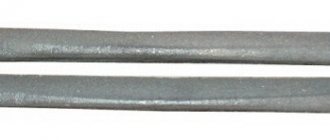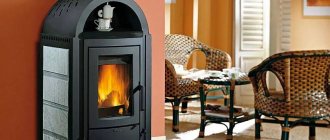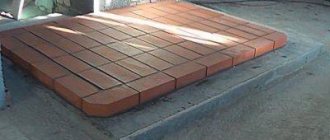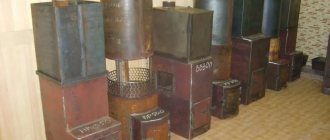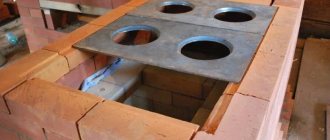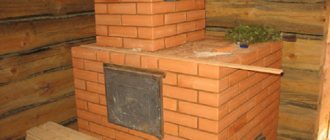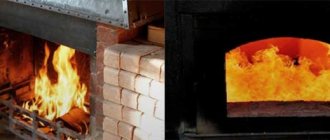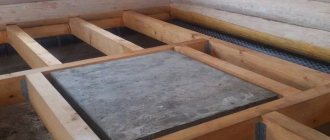A little history
Previously, firewood was burned on a blind hearth - combustion air was supplied through a slightly open fire door.
This method has a fire hazard - coals may fall out of the firebox. It is also difficult to accurately select the optimal combustion mode - the regulator is very rough. The ash that covered the coals over time also did not contribute to the normal combustion of fuel - it is an excellent heat insulator (in the combustion chamber of a Russian stove, this is exactly how coals were stored in the ash for the next kindling). Therefore, they began to install a grate - a grate on the hearth through which oxygen enters the combustion zone. The ash is also removed through the grate - nothing interferes with the combustion processes. The absence of a grate or its damage is not critical - the stove operates without it. True, the efficiency is somewhat lower. And the zone of intense heating of the masonry moves below the hearth - now the base of the ash chamber is also heated. And here you need to be careful if the stove is installed on a wooden base.
What is a grate and why is it installed?
The grate is a grate that allows the air flow to penetrate directly to the combustion site from below, and the ash to fall through the holes into the compartment reserved for it. It can be cast iron or steel. Installing this accessory solves a number of problems. in particular, he:
- Divides the firebox into two zones - the combustion chamber itself and the ash pan.
- Used for placing and drying fuel.
- Distributes the air flow from the ash compartment.
- Provides high-quality traction.
- In combination with the door, it allows you to control and adjust the flame.
It is not possible to make a grate intended for installation in a furnace from every metal. After all, it is exposed to high temperatures and under the influence of atmospheric oxygen can oxidize quite quickly. Only cast iron can resist such a complex destructive influence for as long as possible.
Conclusion
When choosing a high-quality grate, you should take into account the design features of the stove. The choice of a specific design and lattice components depends on the nature of the fuel. A grate for a sauna stove made of cast iron will last longer than the same one made of steel or other metals.
The weight of the fuel itself is also of great importance. Installing gratings does not require special knowledge. You can correctly place the grates in the oven yourself; it is enough to take into account only a few nuances. With the right choice of material and installation, they will last you a very long time.
What types of grate designs are there?
If we talk about products made of heat-resistant steel, then there are pipe and chain varieties of grates.
As for cast iron grates, there are several types:
- Tiled. Such rectangular grates are widely used in solid fuel stoves and boilers, fireplaces. We can say that these are universal products. You just need to choose the right grate size.
- Baskets. This type of grate was used in open hearths where food was prepared. Currently, they are practically never found.
- Beam. Externally, such grates resemble beams for construction. They are single or double stacked parts from which you can build a grill of any size.
- Movable gratings. The peculiarity of this design is that the grille links can be moved in a horizontal plane, changing the clearance between them. As a rule, such grates are used for long-burning furnaces.
Review of grates for fireplaces and stoves
Modern wood stoves bear little resemblance to their ancient counterparts, both externally and internally. They are distinguished by their smaller size, high thermal productivity, and in the combustion part, grates for furnaces have become a traditional part. Not all city dwellers know what a grate is, although various heaters, hearths, potbelly stoves and fireplaces are becoming common attributes in a country house or dacha.
The grate is a cast-iron grate for the stove, separating the firebox and the ash compartment, and serving for laying solid fuel (wood, coal, briquettes). Oxygen from the blower enters through the cracks, thereby enhancing combustion and increasing productivity. Firewood and coal burn with a minimum residue, and ash and ashes fall into the ash pan.
Not every metal is suitable for grates for fireplaces and stoves, because the grate experiences the destructive effects of high temperature and oxygen and gradually burns out. The best and most reliable material is cast iron, which is also used for the manufacture of fittings: doors, latches, decorative elements.
Types of cast iron grates
They come in four types:
1. Tile models are a standard size rectangular grate, used in stoves, fireplaces and boilers. This is a popular shape widely used in prefabricated metal stoves.
2. Beam grates - a stacked structure made of cast iron slats, single or cast in pairs. They are good for non-standard fireboxes of homemade hearths; you just need to take into account the standard length of the structures when forming the installation site. The beams must lie freely and be removed from the firebox, and the gap for expansion must be at least 5 mm, otherwise deformation of the metal and damage to the masonry is inevitable.
3. The basket type was previously used in the open fireboxes of ancient kitchen hearths, but now they have become irrelevant.
4. The movable grate structure is used in long-burning heating stoves. On it you can adjust the width of the gaps, thereby cleaning the oven.
Selection of grates for different fuels
For long and reliable service, the grate must be selected based on the type of fuel used. For firewood and briquettes, grates 330 x 252, 300 x 252, 250 x 252, 250 x 180, 140 x 180, 140 x 120 mm are used. For coal, they should be 350 x 205 or 300 x 205 mm, which is due to the large amount of harmful combustion products that it emits.
It is important that the thickness of the rods support the maximum weight, and the total area of the gaps is 40% of the entire surface of the slab. This applies to both stacked beam grates and industrial casting slabs. Without sufficient ventilation capacity of the grate, the stove will burn poorly and gases may accumulate in it. If the gaps are excessive, fine coals fall into the ash pan without having time to burn out, which will increase fuel consumption.
Assortment and prices
You can buy cast iron grates for a wood-burning stove in branded stores of stove companies, where there is always a wide selection and high-quality material is used. Focus on the cost and weight of the product. Too light and cheap products are not cast iron.
As a rule, heat-resistant fittings are cast from SCh 15 (20) grade; it has optimal heat resistance. Steel grates are cheaper, but over time they deform and become unusable. A good solution would be a beam with a ribbed surface, which reduces the contact of hot fuel with metal. This design extends the service life.
Blower
The vent is the first air chamber in the furnace, which usually has a door. The blower chamber is laid out according to the dimensions of the grate. It can be wider than the grate and overlapped by overlap of rows of side walls up to the grate. Through the ash chamber, air enters the firebox through the grate; in addition, it serves to collect ash and other fuel waste.
Blower: 1 - blower chamber; 2 - blower door
The blower door can be of any size, but no larger than the blower door. Through this door it is convenient to remove ash from the wide ash chamber, and as for air, there is enough of it with a door even half as small as shown. Practice has shown that the best place for the blower door is on the second row of the stove masonry. The door is installed in the blower window, which is connected to the blower chamber. When the door is open, air rushes through the window into the ash chamber. The more the door is open, the more air will enter the ash pan and the better the fuel will burn. Air, especially coming from below, is needed to maintain fuel combustion. Hence the name - blower.
Sometimes the door is used to regulate the draft in the oven: the less the door is open, the less draft. It is not necessary to install a blower door, but it is advisable, because without it a draft can occur in devices that do not close tightly, such as valves. And then the heat will go out into the chimney, and the stove will release less heat into the room.
If there is no door, the draft is adjusted using a valve. The more the valve is open, the stronger the draft, and with it more air will enter the stove and the draft will be stronger, which means the fuel will burn better. If there is no door in the ash window, but there is a view, then the fuel will constantly burn with the same intensity, but with this intensity a lot of heat will go into the pipe, which the brick could absorb. The viewer cannot regulate either thrust or fuel combustion.
Let's say that the door is a few millimeters smaller than shown in the figure. In any case, the seams should be no more than 3-5 mm. To do this, the laying must be carried out from the door to the corner of the stove. The last seam turns out thicker than expected, and such a seam cannot be made. To maintain the thickness of the seams, you need to break off a quarter from a whole brick in the corner of the wall where the door is located. You will get a three-quarter and a quarter. Next, you need to break off a larger quarter, taking into account the thickness of the seam. It will seem to lengthen the whole brick. Instead of a whole brick, you need to put the first three-quarter and the second quarter - it will take the place of the thick seam. The masonry of the top row above this quarter will be made of a whole brick - it will block this quarter. If a thick seam is obtained near the door, then you need to do the same in this place.
If, because of the door, the firebox turns out to be several millimeters narrower and the flues are wider, then this will not affect the operation of the stove. In some areas of the country, stoves are installed without a blower at all. In these furnaces, the combustion doors have windows-openings for air intake instead of a blower. In such fireboxes, only wood and peat fuel burns, but the firewood is buried in ash and forms a lot of firebrands. When they burn out, the heat goes into the chimney, so the firebrands have to be pulled out of the firebox and placed in a bucket of water. Such ovens are made due to the lack of grates. If they exist, then they are installed above the blower chamber.
Criteria for selecting grates for a furnace
The choice of grate is determined by several factors, which include the following:
- Type of heating device (structure).
- The type of fuel used - the grate model will depend on this point. If you plan to heat the stove with coal, then you should purchase more massive grates that can withstand considerable mechanical load and extremely high temperatures. Lighter weight products are suitable for wood fireplaces and stoves.
- The grate must correspond in size to the seat in the combustion chamber. More precisely, the dimensions of the grate are usually immediately included in the design of the furnace, based on the sizes of these products offered for sale.
- The distances between parallel grate bars for wood-burning stoves must total at least 40% of the grate area. This factor will help to avoid difficulties when cleaning the product from ash. In addition, gaps less than recommended will create obstacles to the free circulation of air flow. And this, in turn, will lead to a decrease in the productivity of the heating device, as well as to a decrease in the level of safety of its operation. Insufficient air exchange creates difficulties both for complete combustion of fuel and for normal traction. And the delay of combustion products is unacceptable, as this is fraught with very serious consequences.
What functions do grates for furnaces perform?
This element of stove fittings allows you to achieve high-quality combustion of fuel and maintain it while the stove is burning.
When one portion of firewood or coal burns out, the ash is poured out, and the top layer of fuel is shifted to the grate, where it is better blown by the air coming from the ash pit and burns more intensely. Thanks to the presence of grates, the task of drying wet fuel is simplified.
The efficiency of the furnace depends on the design of the elements, and the durability depends on the material from which they are made. It is also important to install the grille correctly so that it fully performs its functions.
Peculiarities
The grate is made by hand as a single piece; most often, cast iron is used for its production. The grille of the structure has holes through which air is drawn to the fuel.
The part is laid in such a way that the grille holes are directed from the door opening to the rear wall. For large combustion chambers you will need several grates.
It is quite possible to make a grate with your own hands. It is an important element in the combustion chamber, thanks to which it is possible to obtain efficient combustion of fuel. The designs of modern furnaces and boilers are constantly changing, and details are being improved. But there is a functional element that you can’t do without. This element is the grate.
The grate serves to support wood, coal and fuel briquettes. Through its holes, ash pours down, thereby freeing up space for a new batch of firewood. Grate bars vary in design and are made from different materials.
Rules for installing the grate
Without exaggeration, we can say that of all the elements of a modern oven, the grate is one of the most conservative. Despite the constant use of new technologies and the search for modern design solutions, the grate bars in the furnace have remained almost unchanged, such is their successful design. Although, as practice shows, tradition is tradition, but not everyone succeeds in choosing and installing the grate correctly the first time.
A stove design with a closed combustion chamber or an open hearth with a grate will work best with cast iron grates. But the correct choice of this element depends on several factors:
- Combustion chamber size;
- The type of fuel that is planned to be used;
- Furnace designs;
- How to use the oven.
Grate bars cast from cast iron are made in the form of a solid grate, a grate with jumpers, in the form of individual elements and special types of grates designed for open hearths.
The fact is that the length and width of the combustion chamber for stoves of different designs have significant differences. Some stove designs have a rectangular firebox, with grates covering the entire area. For other ovens, a small grate 25 cm wide and 30 cm long is sufficient. Some stoves are designed to fire logs of double length - 80 cm or even 1 meter. Therefore, when choosing, the size of the firebox is taken into account. Single beam models are also important for construction - a full standard grate is not always required, especially in small ovens; many of them are small in size and can get by with 4-5 grates.
For a stove that uses only wood, standard grate sizes of up to 25 cm in length are usually selected. In rare cases, when meter-long logs are used, the grate length is selected to a maximum of 900 mm and a width of 800 mm. But to use a furnace for coal, the grates are selected to be larger in size - 350 by 350 mm. In this type of product, not only the dimensions are increased, the thickness of the casting itself is slightly larger than conventional wood grates, but the distance between them is slightly smaller. This shape is necessary to retain small coals; when burning wood, the size of individual coals is much larger than that of hard coal.
The design of the furnace is also taken into account - for heating furnaces, mainly long grate models are used, in which the casting of the ribs has jumpers between them. And in heating and cooking stove models, grates with a large number of rods in the grate are used, this allows for several modes of fuel combustion and several options for heat treatment of products, from fast heating to slow smoldering on coals.
And of course, experienced stove makers will advise installing grates with rods depending on how the stove will be used. This concerns, first of all, the process of adding fuel to the firebox. If a firebox door is used, then thin grates can be installed, and if loading will be done through burners, then it is worth thinking about the additional strength of the metal.
In order to choose the right tactics for repairing the grate, you need to understand how this element was installed in the brickwork of the furnace. A one-piece casting, as well as a stacked design of individual grates, have their own installation specifics. This concerns, first of all, the thermal gap between metal and brick. And this applies to the masonry of the firebox made of fireclay refractory bricks.
For normal functioning, a gap of 0.5-0.7 cm is made between the metal and the masonry. Cast iron, like any other metal, expands when heated, and this half a centimeter is critically not enough for the normal functioning of the stove.
The second point is that during construction the lattice is installed in grooves prepared in advance in the brick. This allows for reliable fixation of the metal. The grooves are made of sufficient depth so that the top of the grate is flush with the surface of the brick that forms the bottom of the firebox. Fixing the lattice itself is usually not done, since the already large mass reliably fixes it in the structure. However, you can fix the grate with sand or a clay-sand mixture.
A stacked grate of individual grates is usually installed taking into account the thermal expansion of the metal, but the dimensions of the grooves are strictly observed. If the grooves are large, the grate bars will not hold their shape. Many stove makers resort to such a technique as a set of grate bars in a cage. To do this, they use a metal profile or profile pipe, cut along the central axis. The ends of the grate are inserted into the profile, the edges of the profile are welded so that a simple but at the same time rigid structure is obtained.
To fix the grating during laying, cardboard or pieces of fiberboard are usually used. Before the first fire, they are simply removed, leaving a gap free.
When laying a new structure, installing a grate in a furnace does not present any great difficulties. According to the sequential masonry scheme, the vent and the base of the firebox are laid out. A cutout is made in the foundation bricks for the grate. Then the process is simple - laying out the base, installing the grille, fixing it with cardboard.
Ways to solve the problem
If the grate is damaged, there are two options: fill the ash chamber with a brick or install a new grate.
The option of filling is acceptable only if the integrity is damaged or there are cracks and it is impossible to eliminate them at the base of the ash pit. At the same time, it would be good to replace the firebox door from a blank door to a door with a grille to regulate the flow of secondary air. But this option will definitely create a lot of unnecessary trouble and reduce the efficiency of the furnace. Therefore, we change the grate.
The grate is usually made of cast iron. Cast iron is very different from brick in terms of CTE - coefficient of thermal expansion. This indicator for iron is much higher than for ceramics. Therefore, the grate is always placed freely with a gap of 5-10 mm around the entire perimeter. Some manuals recommend filling the gaps between the masonry and the grate with sand. But this is very stupid advice. Unnecessary and even harmful. Firstly, the sand from the heat of the coals (and it can reach 1100 degrees Celsius) simply sinteres - vitrifies, tightly welding the grate to the masonry and depriving it of the necessary freedom. Secondly, after the first fire, this gap is filled with ash - a non-flammable and non-caking material. So why make unnecessary movements?
It is important to place the grate correctly - an inverted grate quickly becomes clogged with ash and stops working. Therefore, we remember that the grate slits expand downward, not upward. Sometimes the grate has a thickening in the middle - this is to equalize thermal stress, and not to roll the coals to the edges, as some people think.
The figure shows the correct (bottom) and incorrect (top) position of the grate
Usually the grate is placed in a brick trough or in grooves selected in the brick. If the integrity of these grooves is damaged and it is impossible to restore them, you will have to come up with some kind of supports. Sometimes they try to get out of the situation by driving nails, metal plates, etc. into the seams of the masonry. All this is in vain - the metal is quickly tempered and ceases to hold the grate, and more massive pieces of iron are unacceptable - they will tear the masonry.
Recommendations for choosing cast iron grates for the stove
A correctly selected grate increases the efficiency of the furnace and reduces fuel consumption. Which option is best depends on:
- type of oven;
- firebox dimensions;
- fuel used.
Type of oven
Each type of grate is better suited to a certain type of heating device. Tiled ones are suitable for conventional stoves and fireplaces. It is better to install cooled ones in solid fuel boilers. Although flat ones are also used, especially in small models.
For long-burning devices, choose a movable option for better regulation of air flow. And when using open stoves, it makes sense to choose a basket model.
An open fireplace with a cast-iron basket-type grate installed in it.
Fuel type
If the stove or boiler is fired with coal, a larger grate is selected. When coal burns, more harmful substances are released, and if there are not enough holes, they will become clogged.
Important! Fuel cannot be extinguished with cold water. Sudden temperature changes reduce the durability of cast iron, and the grate breaks over time.
Firebox size
The size of the grate depends on it. The distance between the grate and the walls is also taken into account.
For standard chamber sizes, standard grilles are selected. If this is not possible, the part is made up of separate beams.
Width of grille gaps
The dimensions of the holes themselves are also important. Ash should be poured into them, but not small pieces of coal or wood.
The total volume of the gaps is usually at least 40% of the grate area. Otherwise, there will be insufficient air supply and combustion efficiency will decrease.
Specifications
There are many types of stoves, varying in size, type of fuel used, and other characteristics. Therefore, the grate for them will also be different. As for the material of the stove itself, it does not directly affect the choice. Grates are installed in brick, steel, and cast iron devices.
Type of design
There are gratings:
- monolithic;
- typesetting;
- refrigerated.
Monolithic are solid structures. Dimensions are selected depending on the depth and width of the combustion chamber.
Available to fit all standard firebox sizes. This option is the easiest to install.
The typesetting version is made up of individual rod elements. It is used if a standard one cannot be selected, for example, in non-factory-made ovens.
Important! Often the rods are wedge-shaped. When installing, they are positioned with the narrower part down
This increases service life.
Cooled ones are used in systems with heat exchangers. They are made of tubes through which coolant passes. Thus, the grate itself is cooled, and the overall efficiency increases. This option is more often used in solid fuel boilers. The temperature inside the chamber reaches 1000°C. Thanks to cooling, the material can withstand a similar thermal load.
Form
The grate bars differ in the shape of the canvas. Different types are used in different designs. The following types of gratings are available:
- flat;
- basket;
- movable;
- beam
Photo 1. Basket grate made of cast iron. This type of device is usually installed in fireplaces.
Flat (or tiled) - the most common type. They are installed not only in stoves, but also in boilers that burn solid fuel, as well as in fireplaces. They have a rectangular shape. The dimensions are standard, selected depending on the dimensions of the fuel chamber.
Baskets have curved edges, which is why the whole structure resembles a basket. Such structures are placed in open-type ovens intended for cooking. Since such stoves are rare nowadays, and the parts for them are also not very common.
Movable grates are installed in long-burning furnaces, where it is necessary to regulate the air flow. The design allows for the possibility of changing the width of the gaps. They have several sections and a shaft, thanks to which movement occurs. Rotation axes can be horizontal or vertical. An additional advantage is greater ease of cleaning.
Beams consist of individual crossbars (beams), which can be single or double. They are typically used in non-standard sized ovens.
Size
The dimensions of the product depend on two parameters:
- dimensions of the furnace combustion chamber;
- type of fuel used.
In equipment operating on wood, peat and fuel briquettes, a width of 150-350 mm (in increments of 50 mm) is most often used.
The depth is usually 180 or 250 mm. The largest possible dimensions of standard models are 900x800 mm.
When coal burns, more harmful substances are formed. Therefore, the dimensions of the grille should be larger, from 300-350 mm on both sides.
In any case, gaps of at least 5 mm are left at the edges. They serve to compensate for expansion when heated.
Attention! When choosing a size, the weight of one load of fuel is also taken into account. Dimensions, especially thickness, are selected in such a way as to withstand this load
Practical advice for choosing
When choosing a grate of a certain model, it is necessary to take into account not only the type of material and size of the fireplace, but also the type of fuel used. Thus, coal-fired heating devices require the installation of a grate of 300-350x205 millimeters. Fireplaces using wood or briquetted fuel require the use of a grate from 140x120 mm to 330x252 mm. The grate bars must be able to withstand the weight of one load of fuel. All these nuances can be clarified with the seller of the store where you are planning to purchase stove fittings. Solid combustion products will freely fall through the grill bars if the gaps occupy slightly less than forty percent of the area of the entire device. If the gaps take up less space, then air will not be fully supplied to the fuel, and the fireplace will begin to operate at a slower rate. And if the area of the gaps is larger, the fuel will begin to burn instantly, without having time to release heat into the room.
Dimensions
Another condition for choosing a grate for a stove is its length and width. The sizes of the grate for the furnace are different, they are determined by the type of fuel:
- For light firewood or briquettes, grates from 140x120 mm to 330x252 mm are sufficient.
- For coal, larger parameters are needed: 300x300, 350x300, since this fuel emits a large amount of harmful substances when burned.
Variety of grate sizes
Buying tips
For high-quality combustion, not only the size of the grate is important, but also the weight of the fuel that it can withstand in one laying. The rods should not deform or wear out.
The grate must have a sufficient number of holes - at least 40% of the area of the part itself. If this figure is lower, then there will not be enough oxygen to maintain the fire, and the ash will remain on the grate and clog the stove.
If the gaps in the grate have a large area, then the remaining fuel will fall from the combustion chamber into the ash pan. Fuel consumption will become uneconomical.
Price policy
A quality product cannot have a low price. High-quality cast iron parts that will last for many years are expensive. And vice versa, light and cheap ones, made from a mixture of unknown materials, will quickly become unusable.
Approximate prices for furnace grates:
| Size | Price |
| 800x200 mm | 1200-1600 rub. |
| 915x250 mm | 1100-3000 rub. |
| 260x540 mm | 400-500 rub. |
It is better to buy these products in specialized stores. They provide a wide selection of models with different materials and price categories. Consultants will help you make the right choice based on your preferences, the nature of the fuel, and the frequency of operation of the heating device.
Do-it-yourself grate: materials, design, stages of work
As already mentioned, it is easier and easier to make a grate for a stove with your own hands from steel.
There are several options here. The only difference is the purpose for which the lattice needs to be made. For small stoves, which are mainly used for periodic heating of premises, for example, for a potbelly stove, you can use construction fittings with a diameter of 10-12 mm. But for capital heating or heating-cooking stoves, it is better to pay attention to two options - from structural reinforcement or from corners. The advantage of steel reinforcement lies in the availability of this material and the possibility of using previously used sections. In addition, steel reinforcement is more suitable for grates; it does not burn out so quickly, and it is not greatly deformed under the influence of temperature. On the other hand, to assemble this element it is necessary to use reinforcement with a large diameter - 16,18 or even 20 mm. This makes it possible to extend the life of the grille.
The use of steel angles makes it possible to quickly replace a worn-out element; they are not as expensive as other types of rolled products, and by their design they are able to withstand a greater number of heating and cooling cycles than a profile pipe or rod.
The manufacturing technology is quite simple. To assemble a structure from steel reinforcement, it is recommended to first make simple calculations. First you need to calculate the geometric dimensions of the lattice. Here the length, width and height of the product are taken into account. In this case, the height plays no less a role than the length and width; a discrepancy between the height and the cast iron parameter will not allow the grate to be correctly installed in place. A height that is too small will interfere with proper loading of fuel, and a height that is too high will raise the grate above the surface of the bricks, and thus create a space in which ash and unburned fuel will accumulate.
The next step is to calculate the area of the grating. Next, the number of rods is calculated. First, 40% of the area is calculated, approximately how much is occupied by the spaces between the rods. And then the number of rods is calculated. When calculating, it is recommended to round the resulting values; it is not necessary to strictly adhere to the figure of 40%; nothing bad will happen if the gaps are 35 or 45% of the grating area.
The stage of practical work begins with the preparation of material for work - first, the rods are cut; accuracy and precision are required here. After this, a template for assembly is made, markings are made on a section of the board, and nails are simply hammered in to secure the sections of reinforcement. After checking the correctness of the layout, electric welding connects all the elements into one structure. First, tack is done at several points, and then all seams are finally welded around the entire circumference.
Upon completion, the resulting structure is checked in all planes; this is done on a flat surface using a bench angle - all angles must be correct, the lattice itself must be in the same plane. No bends or deformations.
It is possible to make a grate with your own hands. What to make a grate for the oven from? It is better to use heat-resistant steel as a material, because it is impossible to work with cast iron at home. To make the grille, you can use any materials that have heat-resistant characteristics. This could be fittings, corners, steel pipes or strips of metal.
To make grate bars you will need:
- the metal from which the grille will be made,
- steel rods for creating partitions;
- ruler, tool for making marks;
- grinder for cutting material;
- welding.
It is not difficult to make a grate from reinforcement yourself. It is enough to select the desired length of the product and cut the reinforcement with a grinder. It is necessary to determine the number of strips and take into account clearances for ventilation.
When the required amount of material has been prepared, you can begin welding the grate using rods. Do-it-yourself grate bars for the stove made from reinforcement can be seen in the photo below:
Making a grate for a stove with your own hands from a corner is even easier than from fittings. To do this, it is enough to weld two corners of the required sizes together: one side is equal to the width of the product, the other to the length. The result will be a rectangular base for the future part. The grate can be made from reinforcing bars or thick mesh.
Tool
List of required tools:
- welding machine;
- angle machine;
- sander;
- drill;
- vice;
- hammer;
- tape measure and ruler;
- square;
- pencil.
Self-installation of the grate in the oven
Installing grate bars yourself is not that difficult. Their location should be the thickness of a brick below the firebox door. This prevents burning fuel from falling out when the door is opened.
Next, you need to cut off the ledge in the firebox and install the grate in this place with the edges. It is imperative to maintain a thermal compensation gap of 0.5 centimeters on all sides. This gap is necessary so that the cast iron, expanding when heated, does not damage the masonry.
Installed grates in the oven
If a stacked structure is being installed, the grate bars must be mounted with the wide side up. It is not recommended to close them tightly so as not to fix them firmly. It is enough to fill the grooves with sand without cement. This will ensure that the structure fits well in place and unhindered expansion of the metal when heated.
Tile grate
One of the most common types of grate is the tiled grate. The main feature of this design is the observance of strictly fixed dimensions. This grille is designed for an installation site of a certain size.
A mandatory condition must be met - the presence of a gap between the outer perimeter of the grate and the walls of the firebox of at least 5 mm. If this size is not maintained, the cast iron grate may expand greatly when heated and damage the firebox.
Pros and cons of using cast iron grates for furnaces
The grate is a necessary part of the stove design, without which the fuel burns much worse. It is used in all types of stoves and fireplaces, as well as in solid fuel boilers.
The materials used are heat-resistant steel or cast iron. The first option is cheaper, but lasts less because it is susceptible to corrosion.
Cast iron is more durable and better withstands high temperatures. But this is a rather fragile material, and therefore during the installation process cast iron parts must be handled extremely carefully.
